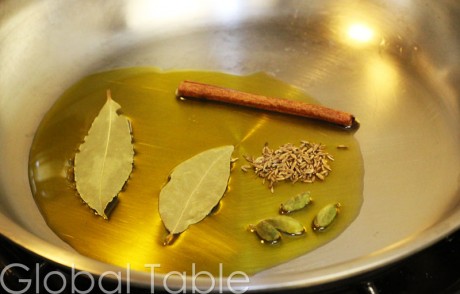
The people of Bangladesh typically store their spices whole. This is because husks, shells, and pods keep spices’ sizzling potential sealed in better than any Tupperware or glass jar.
To season food they simply dry roast a small batch of whole spices and then grind them into powder. Preparing spices as needed ensures food with the most vibrant, intense flavor. After all, spices dramatically lose their pungency after only 6 months (sooner if exposed to heat and sunlight).
The flavor difference can be compared to making a cup of tea from a fresh tea bag or from a used tea bag. Or a handful of dust.
Big difference.
I know, I know. You’re thinking… but, Sasha, my spices are fine. And that’s probably true. Just … fine….
But wouldn’t you rather your spices be explosive? Outrageous? Wide-eyed wonderful? Like Michael Jackson in thriller?
I thought so.
One easy method for dry roasting spices:
Heat a skillet over medium-low heat. (do not use a non-stick pan as the coating should never be heated up dry)
Add spices and keep swirling the pan around to keep them moving.
Roast whole spices for about 30 seconds-1 minute.
Roast ground spices for 10 -2o seconds.
You’ll know when they are done because they’ll smell great and even begin to sputter and pop a little.
Keep your eye on the spices at all times to avoid burning. Spices go from “raw” to burnt in a split second.
What you’ll need to grind your spices:

A Bangladeshi grinds a masala blend of clove and coriander seed. Photo courtesy of http://ishouldcocoa.wordpress.com
Pick one of these 4 Basic Tools to grind your spices.
– Mortar & Pestle (uses the most muscle, but a good coarse grind is easily attainable)
– Pepper Mill (this works in a pinch when set to the finest grind)
– Electric Spice Grinder (modern cooks love this contraption – the small size is efficient and with the flip of a switch it obliterates any spice into a fine, powdery, omg-good grind)
– Blender (this pinch hitter works okay for larger batches and/or if you don’t have a spice grinder)
Dear Santa,
I would really like an electric spice grinder. Like, tomorrow. Just don’t tell my mortar and pestle.
Thanks ever so much!
Love,
Sasha
Spice Terminology from the Indian Subcontinent:
1. Garam Masala
Masala is the Hindi word for “spice” and can be used to describe a spice blend that includes herbs and aromatics like ginger or garlic.
Garam means “warm,” referring to the Hindi belief that some spices are good for the soul.
A beautiful explanation of Bengali Garam Masala with recipes is available at “Bong Mom.” In her post she describes the four typical components of their regional masala : Clove, Cardamom, Cinnamon, and Tej Patta.
2. Panch Phoron
Panch means five and phoron means flavor, literally making Panch Phoron Bangladeshi 5 spice. The typical spice blend includes fennel seed, mustard seed, black nigella, golden fenugreek and brown cumin seed.
Don’t feel like grinding your spices? Go for Panch Phoron! According to Bong Mom,
Panch Phoran is used mainly for tempering, to flavor the hot oil before adding rest of the ingredients. The essence being tempering with Five Spices. It is usually never ground or used as a powder unlike other spices which are used both in whole and ground form. However dry roasted panch phoron is ground to make a powder that is sprinkled on chutneys. But it is NEVER used in powder or paste form in any other preparation.
Source: Bong Mom
And, hey, between you and me? If this is all too much, just dust off your spice jars and use what you’ve got! Simply trying new spice combinations is an exciting feat in itself!




8 Comments